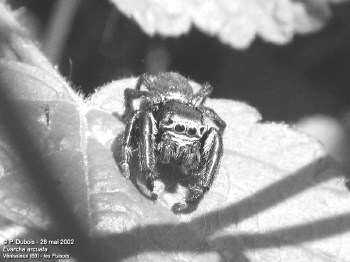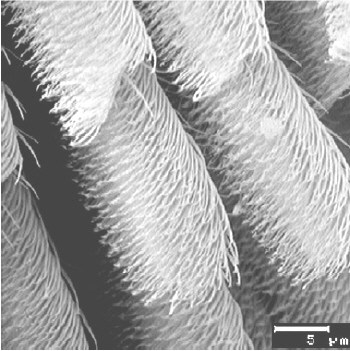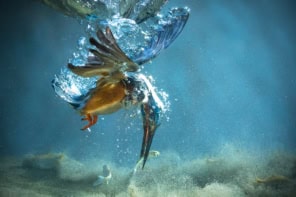Spiders can walk upside-down across almost any type of surface because they exploit electrostatic, van der Waals forces, according to a team of German and Swiss scientists. The team has also calculated that these forces are strong enough to allow the animal to carry more than 170 times its own body weight (A Kesel et al. 2004 Smart Mater. Struct. 13 512). The results could be exploited to develop new types of adhesives.

Antonia Kesel at the Institute for Technical Zoology and Bionics in Bremen and colleagues at the University of Zurich used a scanning electron microscope to image the foot of the spider, E. arcuata. This species is a member of the jumping family of spiders (Salticidae) that catches its prey without building a web.
The scientists found that the spider’s legs contain a tuft of hairs, and that each individual hair in the tuft is covered by hundreds of thousands of smaller hairs – called setules – just hundreds of nanometres in width. The spider uses these setules to stick to surfaces (see figure 2).
By using atomic force microscopy, Kesel and co-workers then showed that each setule can produce a force of over 40 nanonewtons. This is extremely high considering that a spider typically has a mass of only about 15 milligrams. According to the Bremen-Zurich group, van der Waals forces between individual molecules – which are only nanometres apart – in the setules are responsible for this adhesive force. These individual forces combine to produce a very strong overall force on each of the spider’s eight feet.
The team calculated that if 600 000 tips are in contact with a surface, a spider can produce a total force of about 0.025 Newtons, which means it could carry 173 times its own body weight. Moreover, the forces are not affected by the environment and this allows the spiders to walk across wet or slippery surfaces.
“One possible application of our research would be to develop Post-it notes based on the van der Waals force, which would stick even if they got wet or greasy,” said Kesel. “You could also imagine astronauts using spacesuits that help them stick to the walls of a spacecraft – just like a spider on a ceiling.”
The spiders’ sticking ability is superior to that of other arthropods (insects and crustaceans), who use a fluid adhesive to attach themselves to a surface. In contrast, E. arcuata’s behaviour is similar to that of geckos.
“We carried out this research to find out how these spiders have evolved to stick to surfaces, and found that it was all down to a microscopic force between molecules. We now hope that this basic research will lead the way to new and innovative technology,” said Kesel.




